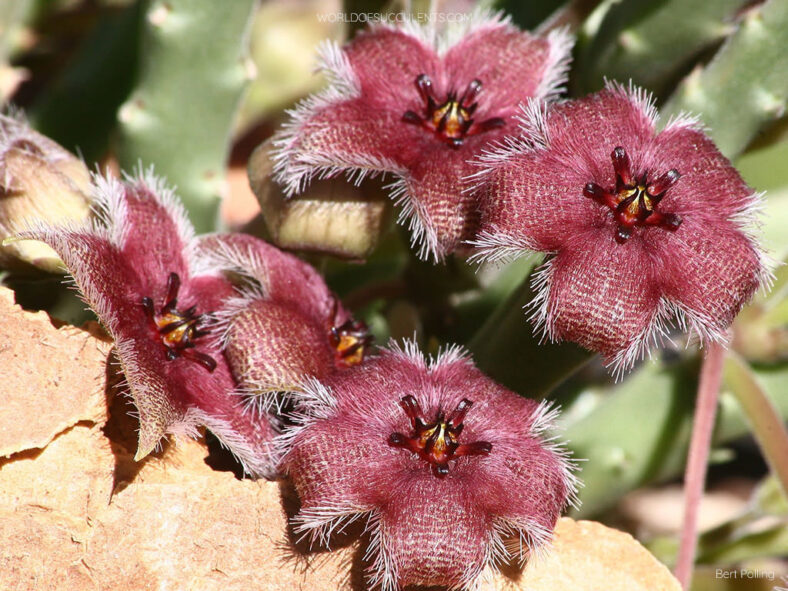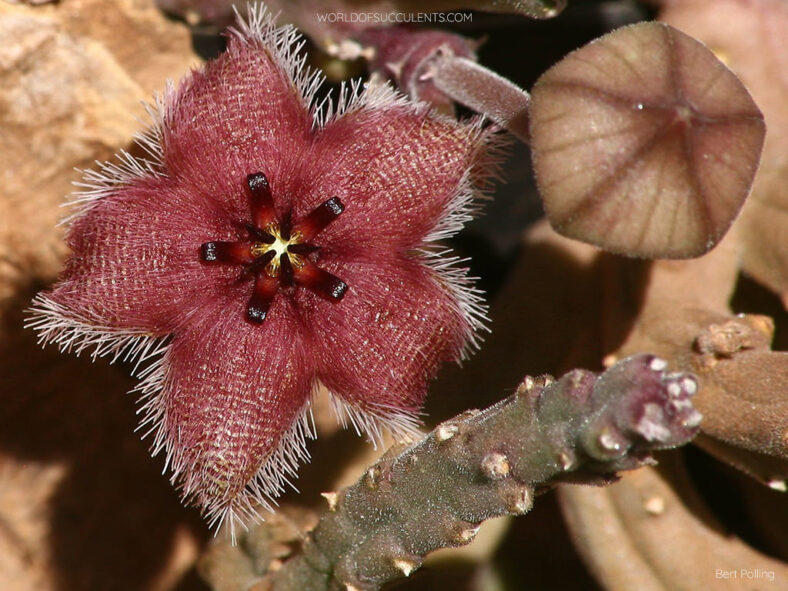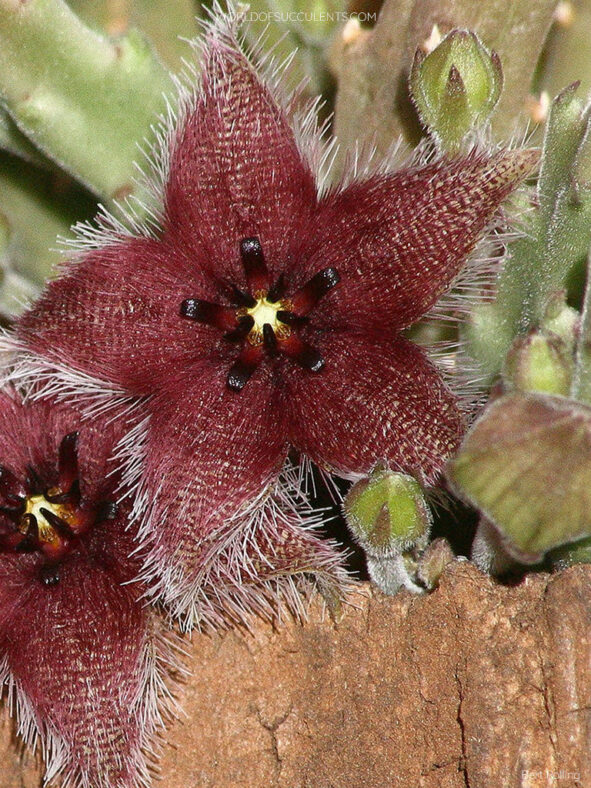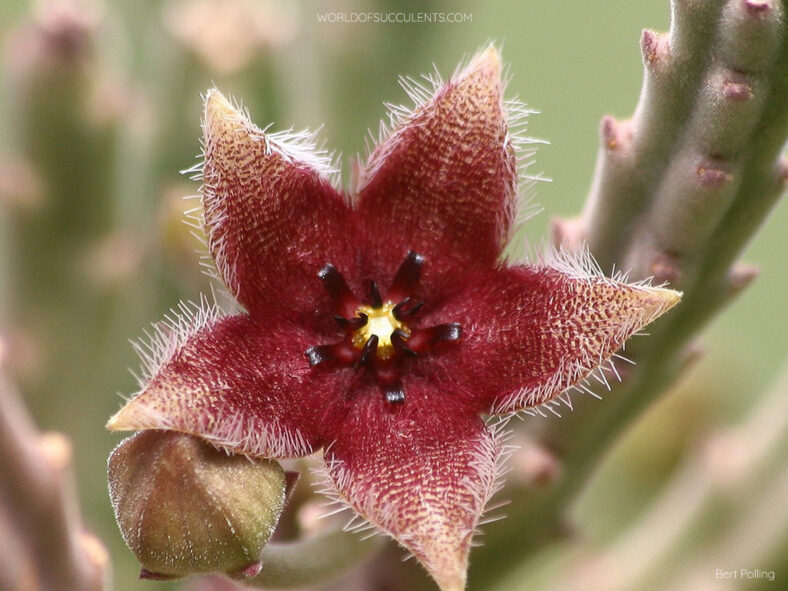Stapelia paniculata is a variable species with three recognised subspecies. It was first described by Carl Ludwig Willdenow in 1814.
Scientific Name
Stapelia paniculata Willd.
Synonym(s)
Ceropegia paniculata, Gonostemon paniculatus, Stapelia concinna var. paniculata, Stisseria paniculata, Tridentea paniculata
Scientific Classification
Family: Apocynaceae
Subfamily: Asclepiadoideae
Tribe: Stapeliae
Genus: Stapelia
Etymology
The specific epithet "paniculata" (pronounced "pan-ick-yoo-LAY-tuh") means "with branched inflorescences, tufted, paniculate, with panicles" and refers to the arrangement of the flowers of this species.
Origin
Stapelia paniculata is native to South Africa. It grows on lower sandstone slopes from Lambert's Bay in the Western Cape province to the Eastern Cape.
Description
Stapelia paniculata is a small succulent with upright stems that have tubercles joined into four obtuse angles along the length of the stem. This plant forms compact clumps that can reach a diameter of 6 inches (15 cm). The stems are slightly grooved between the ribs, covered with short, soft hair. They are green, often mottled with purple, and can grow up to 6 inches (15 cm) long and 0.5 inches (1.2 cm) thick. The leaf rudiments can measure up to 0.06 inches (0.15 cm) long.
During the fall, Stapelia paniculata produces finely hairy inflorescences, each bearing 1 to 10 flowers that develop in close succession. The corolla can reach a diameter of 1 inch (2.5 cm) and is reddish-green on the outside, adorned with 1 to 5 darker veins on each lobe. The interior is typically obscurely transversely wrinkled, mainly ranging from red-purple to dark maroon, and may have yellow lines around and below the base of the lobes. The inner surface of the corolla is covered in sharp-tipped hairs, which can be purple to white. The longest hairs are found along the margins of the lobes, often appearing translucent-white. The corona is dark maroon and raised on a reddish stipe.
Subspecies of Stapelia paniculata
- Stapelia paniculata subsp. kougabergensis: This subspecies is found in the Kouga Mountains.
- Stapelia paniculata subsp. paniculata: This subspecies occurs in several scattered locations, ranging from Lambert's Bay in the south to the northern edges of the Piketberg. It has also been collected in the Piekenierskloof Pass near Citrusdal. Its stems can be up to 0.4 inches (1 cm) thick. The interior of the flowers is red to purplish, often having obscure, transverse, paler lines.
- Stapelia paniculata subsp. scitula: This subspecies has a restricted distribution, specifically in Robertson in the Western Cape province. Its stems can reach a thickness of 0.3 inches (0.7 cm).

How to Grow and Care for Stapelia paniculata
Light: Stapelia paniculata thrives in full sun or partial shade during the hottest summer days. Too much sun causes the stems to develop a protective pigmentation or get sunburned. Not enough light leads to weak, thin stems and fewer flowers. Indoors, place the plant near a sunny window in your home.
Soil: The right soil is crucial to growing a healthy plant. Use commercial soil for succulents, or prepare your own mix with 50% to 70% mineral grit, such as coarse sand, pumice, or perlite.
Temperature: This plant thrives in warm outdoor environments but does not like winter cold and should remain moderately dry and warm during its winter dormancy. Stapelia paniculata grows best in USDA Plant Hardiness Zones 11a to 11b, with average minimum winter temperatures ranging from 40°F to 50°F (4.4°C to 10°C).
Watering: It has typical watering needs for a succulent. During the growing season, water your plant thoroughly and allow the soil to dry before watering again. The plant goes dormant in winter and needs almost no water, about once a month.
Fertilizing: To keep it thriving, fertilize during the growing season. Feed with water-soluble fertilizer diluted to half the recommended strength.
Repotting: Stapelia paniculata will benefit from fresh potting soil every 2 or 3 years. Repot it in spring, just before the growing season starts. Pick a container with drainage holes.
Propagation: The best way to propagate this succulent is by stem cuttings. It is also easy to grow from seeds. Take cuttings during the growing season to ensure good rooting, and sow the seeds in spring.
Learn more at How to Grow and Care for Stapelia.
Toxicity of Stapelia paniculata
Stapelia paniculata has no toxic effects reported. It is safe around pets and humans.
Links
- Back to genus Stapelia
- Succupedia: Browse succulents by Scientific Name, Common Name, Genus, Family, USDA Hardiness Zone, Origin, or cacti by Genus
Photo Gallery
Click on a photo to see a larger version.


